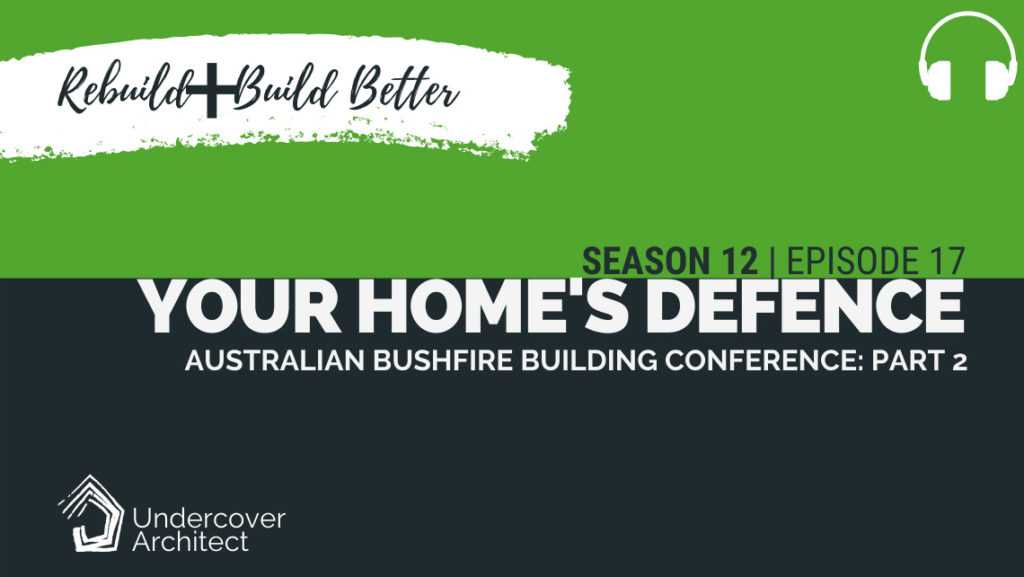
What’s the most significant thing you can do to make your home more resistant in the event of a bushfire?
When I attended the Australian Bushfire Building Conference in September, I was really interested to hear a lot of discussion about this topic: focussing on the importance of defence in any bushfire building strategy.
This is Part 2 of my recap of the Australian Bushfire Building Conference. (You can listen to PART 1 here).
In this episode, I want to take you through what was discussed in regards to active defence, and its role in protecting your property and home in the event of bushfire – or any fire for that matter.
Since we’ve moved to a more regional area, I’ve found it’s a regular thing to get letterbox drops at certain times of the year, or ads on the television, reminding you to get your fire plan in place.
It’s not something I’d experienced before moving here. And, if I’m brutally honest with you, it’s not something I’d actively thought about until the week or so prior to having bushfires 14km away from our home in November 2019, as the Black Summer bushfire season started in Australia.
So, in November, it was DRY. We were buying in feed for the cows, and there was a mess of hay in paddocks near the house where they come in each day to feed and get water.
My husband purchased a pump that we could use for fire-fighting if we needed to, and tested it by connecting it up to the pool. We had a generator if we lost power. And in the days prior, as the fires got closer and friends further into the suburb were being told to evacuate, we started formally prepping the house.
That meant filling the gutters, hosing down the roof, clearing around the house, removing debris and leaf litter … all the things you may be familiar with. My hubby and inlaws did most of it, whilst I photographed and video-ed all our belongings, and packed what I could into the car incase we needed to leave.
As far as I was concerned, we had macadamias on a neighbouring property, and camphors on our southern side. They’re the two most flammable species of trees. And we had one road out, otherwise we’d be on foot. We were not going to hang around.
Fortunately, it never came to that. I’ve never watched wind directions or weather reports as much as I did during that time, and we had one amazing day where the wind changed direction and the fire blew back on itself and gave the firies the chance to get on top of it. The threat stayed imminent for a while, but not so urgent.
Now, thanks to the rain we had in February, and some of the downpours we’ve had since, everything is much greener. Creeks which had stopped running are much fuller. Our tanks are too. But summer is looming, and I’m thinking of what we need to do to be better prepared for another bushfire season that may be around the corner.
In my research for this ‘Rebuild + Build Better’ season, I saw a lot of examples where properties were only saved because someone had been there to defend them.
There was a vivid example from the recent fires where a woman returned with her family to find her home was still intact – and she was shocked because so many others were lost. As she surveyed her home, she found an area of charring on the back of the property, up the rear wall, but that was the extent of damage.
Later, she crossed paths with a volunteer who had stayed and walked the streets with other volunteers to help defend from the fires. And this volunteer, on finding out where this woman lived, said that she had seen flames ignite the home, but she’d been able to put them out before they took hold of the home.
I had the incredible privilege of speaking to an amazing man, Matt Falla. For six and a half years after the Victorian Black Saturday fires of 2009, Matt was one of the co-founders of a recovery group. Called the Community on Ground Assistance (COGA) group, it was established after the 2009 Black Saturday bushfires with a simple aim – to support survivors and those affected on the ground, however that may be.
Matt told me that he’d battled to save his own home from those fires, helped by his daughter who was 9 at the time. In the lead up to the fires coming through where Matt lived, his partner had gone to visit her family, and because of the terribly hot weather, they’d decided she should stay there for a bit longer – she was in air conditioning. However, by the time she chose to come home, the fires were closing in, and she couldn’t get through to her partner and daughter.
This was the thing that blew me away. Matt said “We had a fire plan, but it was a plan based on two adults being there.” It was never intended they’d be in the situation they ended up being in.
And that brings me to the discussion I wanted to have in this podcast, and that’s about the role of defence in your strategy for rebuilding after bushfire, or building in a bushfire prone area.
In this episode, I share learnings from speakers including:
- Professor Owen Price, University of Wollongong
- Catherine Ryland, CR Bushfire
- Ms Sue Bell, Landscape Architect and Principal Urban Designer for the Blue Mountains City Council
- Dr Douglas Brown, Bushfire Architecture
- Sarah Lebner, Principal Architect from Lighthouse Architecture and Science
Associate Professor Owen Price, spoke about research carried out on the 2013 Linksview Bushfire. Owen works at the Centre for Environmental Risk Management of Bushfires at the University of Wollongong, and did a study into the determinants of house loss in two wildfires in eastern Australian in 2013.
This research showed that householders have a vital role. Defence was the biggest factor in the survival of the home.
Catherine Ryland from CR Bushfire and Planning, mentioned that maintenance programs are the big gap, and enforcement and compliance is being considered to ensure a management regime for routine inspections of APZs.
Ms Sue Bell, Landscape Architect and Principal Urban Designer for the Blue Mountains City Council, gave a great presentation on incorporating landscape design to improve bushfire performance. This included thinking about how water can improve your defendability in many ways.
Dr Douglas Brown from Bushfire Architecture, spoke about the fact that, in response to the recommendations from the 2009 Royal Commission, a standard was released for Bushfire Bunkers.
One of the issues that Dr Brown pointed out with the standard is that the shelters or bunkers need to be single-purpose, because it’s seen to be risky that it have a secondary purpose, such as storage, or a wine cellar for example, that may compromise its use in an emergency – the very purpose it was built for.
Sarah Lebner, Principal Architect from Lighthouse Architecture and Science gave a fantastic presentation that was called “Designing for Active Defence”.
Sarah wanted to encourage designers and industry professionals to consider how they could design-in better opportunities for people to defend their property, and stay safe when they’d decided to stay and defend.
There was some great information shared at the Australian Building Bushfire Conference, and it was amazing to see so many passionate and experienced professionals in this area, generously sharing their knowledge and expertise. I hope you found this episode helpful as a wrap-up,
LISTEN TO THE EPISODE NOW.
RESOURCES MENTIONED IN THIS PODCAST:
Matt Falla and Community on Ground Assistance (COGA) >>>
https://mountainviews.mailcommunity.com.au/mail/2015-06-23/job-done-and-dusted/
CSIRO Research re Ember Attack
https://www.bushfirecrc.com/sites/default/files/downloads/act_bushfire_crc_report.pdf
Bushfire Asset Protection Zone Explained >>>
https://youtu.be/1VeNhD5NGdM
Bushfire Bunkers – Victorian Standard >>>
https://www.cfa.vic.gov.au/plan-prepare/private-bushfire-shelters-or-bunkers
NATSPEC Guideline for Bushfire Protection >>> https://www.architecture.com.au/wp-content/uploads/NTN-DES-018-Bushfire-protection.pdf
Bushfire Buddies for blocking downpipes and gutter flooding >>>
https://gutterblock.com.au/product/buy-bushfire-buddy-online/
Phillip Withers, Landscape Architect – Free Guide ‘Best practices for landscaping for bushfire resilience’ >>>
https://architectsassist.com.au/wp-content/uploads/2020/09/PW_ArchitectsAssist_23.09.20.pdf


 With over 30 years industry experience, Amelia Lee founded Undercover Architect in 2014 as an award-winning online resource to help and teach you how to get it right when designing, building or renovating your home. You are the key to unlocking what’s possible for your home. Undercover Architect is your secret ally
With over 30 years industry experience, Amelia Lee founded Undercover Architect in 2014 as an award-winning online resource to help and teach you how to get it right when designing, building or renovating your home. You are the key to unlocking what’s possible for your home. Undercover Architect is your secret ally
Leave a Reply